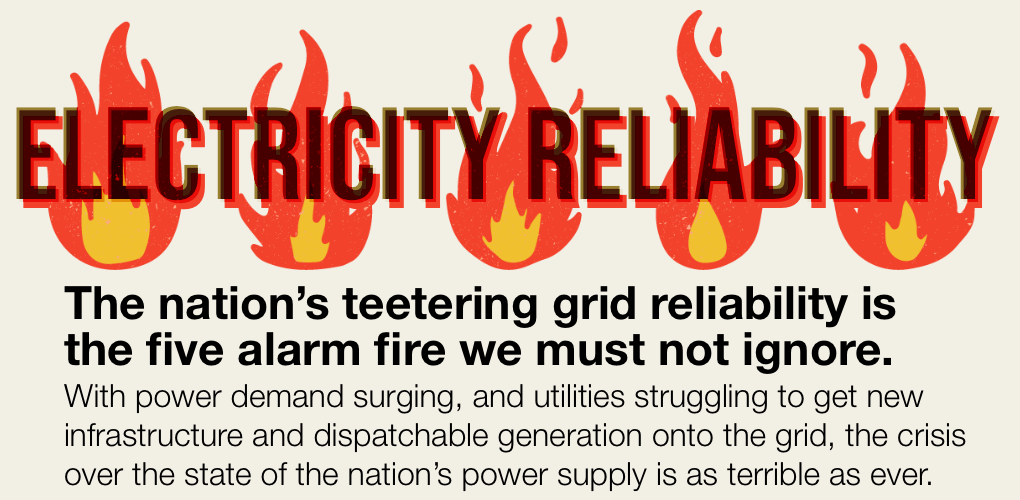
Reliability is a “Five-Alarm Fire”
Rising electricity prices and their impact on the economy and ballot box have become front page issues. However, the nation’s teetering grid reliability is the crisis we must not ignore. With power demand surging, and utilities struggling to get new infrastructure and dispatchable generation onto the grid, alarm over the state of the nation’s power supply is as high as ever.
Last week, Jim Robb, president of the North American Electricity Reliability Corp., the nation’s reliability watchdog, called the nation’s grid reliability a “five-alarm fire.” Robb, addressing at a Federal Energy Regulatory Commission (FERC) technical conference, said that while reliability appears strong on paper today, an increasing number of small-scale events and near misses are reinforcing how tenuous the situation has become.
Robb cited dwindling resource adequacy, extreme weather, interdependency with the overstretched natural gas system, huge new power demand and challenges to site and permit needed infrastructure, among other issues, as driving concern. His remarks were echoed by several FERC commissioners, including David Rosner, who said, “I see our grid as needing every single megawatt, every single electron and every single molecule we can get to meet demand on those peak days and peak hours.”
Peak demand – both in the summer and winter months – continues to push grids across the country to their very limits. Just a few weeks ago, former FERC Chairman Mark Christie warned, “The reliability threat is not on the future horizon. It is actually here now.”
The urgent need for more power – particularly dispatchable power – is not only pushing utilities to delay or outright cancel coal plant retirements but it’s now driving interest in new coal plants.
A Future for Coal CCS
Wood Mackenzie reports that 8 Rivers, a developer working on carbon capture and storage (CCS), is assessing the potential for a new coal-fired plant equipped with CCS with partners in Wyoming, New Mexico and North Dakota. It’s soon expected to select one of these three potential locations for its first project.
Instead of a retrofit of an existing plant, 8 Rivers’ new project would use gasification technology and the Allam-Fetvedt Cycle to produce power and pure carbon for potential industrial use and storage. While grid-scale CCS remains in its infancy, this project could represent a leap forward and reflects the momentum created by policy support in the form of the 45Q carbon capture tax credit and the $625 million recently made available by the Department of Energy for coal generation.
Wood Mackenzie observed that with this significant policy support, “8 Rivers is aiming to deliver power at a price of about US$100 to US$120 per megawatt hour. That would be highly competitive against even unabated natural gas generation at today’s prices, following significant cost inflation in that sector.”
Notably, the plant’s emissions would also be much lower than existing gas. Wood Mackenzie noted, “It is estimated that the carbon intensity of the power from 8 Rivers’ plants could be about 9 kilogrammes per MWh. For comparison, the average carbon intensity of gas-fired generation in the US is about 450 kg/MWh.” That’s a significant jump and a deeply attractive proposition for data centers and large industrial energy users looking for low-emission dispatchable power.
We know with certainty existing coal generation is critically important to meeting the nation’s surging power needs. Advanced coal generation equipped with CCS would be a major breakthrough for U.S. energy leadership and a deeply important leap forward for the global coal industry.
With global coal demand continuing to grow, and coal proving irreplaceable in affordably and securely meeting soaring global energy demand, new, cost-effective technolgy solutions are essential to building the industry of tomorrow both here and overseas where coal demand is growing fastest.
- On October 29, 2025
